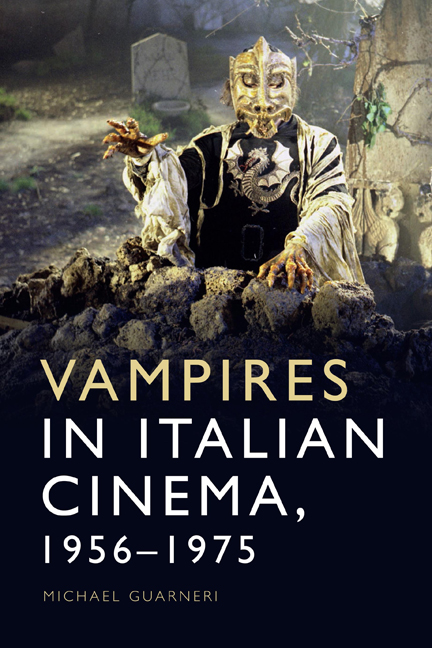Book contents
- Frontmatter
- Contents
- Figures and tables
- Acknowledgements
- Introduction
- PART I THE INDUSTRIAL CONTEXT
- PART II VAMPIRE SEX AND VAMPIRE GENDER
- PART III SANGUINE ECONOMY, BLOODY POLITIC
- Appendix A Three Italian vampire films that were never made
- Appendix B Files from the Italian Show Business Bureau fonds at the Archivio Centrale dello Stato in Rome
- Bibliography
- Index
4 - Male vampires
Published online by Cambridge University Press: 10 October 2020
- Frontmatter
- Contents
- Figures and tables
- Acknowledgements
- Introduction
- PART I THE INDUSTRIAL CONTEXT
- PART II VAMPIRE SEX AND VAMPIRE GENDER
- PART III SANGUINE ECONOMY, BLOODY POLITIC
- Appendix A Three Italian vampire films that were never made
- Appendix B Files from the Italian Show Business Bureau fonds at the Archivio Centrale dello Stato in Rome
- Bibliography
- Index
Summary
POST-WAR ITALY's MASCULINITY IN REAL LIFE AND ON FILM
The previous chapter has shown that, in the early phase of the Gothic horror filone, misogynistic repression coexisted with more ambivalent narrative dynamics highlighting the hardships women have to face in a man's world. At closer inspection, Il mulino delle donne di pietra's titular museum-mill is a perfect metaphor for Wood's (1979a, [1970] 1979b and [1979] 1985), Williams's (1984) and Berenstein's (1996: 9–10) idea that horror is a highly contradictory genre in which the enforcement of the political, socio-economic, racial and gender status quo goes hand in hand with a subterranean critique of dominant ideology. First, the museum-mill does not only showcase sculptures of infamous serial murderesses and stereotypically evil women like Salomé, as it is often misreported in plot synopses, but features a problematic hybrid between femme fatale and tragic lover (Cleopatra), a queen beheaded for court machinations (Anne Boleyn or, less likely, Mary Stuart) and a martyrised national heroine (Joan of Arc) too. Second, all these statues – whether representing so-called ‘good’ or ‘bad’ female archetypes – contain the corpses of innocent girls bled dry by two middle-aged men obsessing over young and beautiful Elfi due to borderline-incestuous attachment (her father, professor Wahl) and sheer lust (her suitor, doctor Bohlem), which certainly begs the question of who the actual vampire of the narrative is. Such a question, however, has rarely, if ever, been asked in the academia. After Clarens's (1968: 190–4) and Mora's (1978: 289–342) seminal analyses of the Gothic horror flone, there has been a tendency to see ‘the Italian horror film’ as ‘concentrat[ing] almost entirely on the devastating effects of a sexually provocative witch/vampire woman on hapless masculinity’ (Newman 1986a: 22), to the point that the male vampires appearing in Italian cinema have never been studied in depth.
Contrary to their female homologues, who remained confined to horror/ thriller hybrids, supernatural horrors and pepla, in the aftermath of the Hammer Dracula's worldwide box-office success male vampires started appearing in almost every genre of Italian cinema, extending their domain from chillers and sword-and-sandal adventures to comedy, and even popping up for a cameo in Mario Amendola's 1963 Sexy proibitissimo, one of the last striptease compilations attempting to exploit the extraordinary box-office success of Alessandro Blasetti's 1959 Europa di notte (see Chapter 1).
- Type
- Chapter
- Information
- Vampires in Italian Cinema, 1956-1975 , pp. 107 - 124Publisher: Edinburgh University PressPrint publication year: 2020



